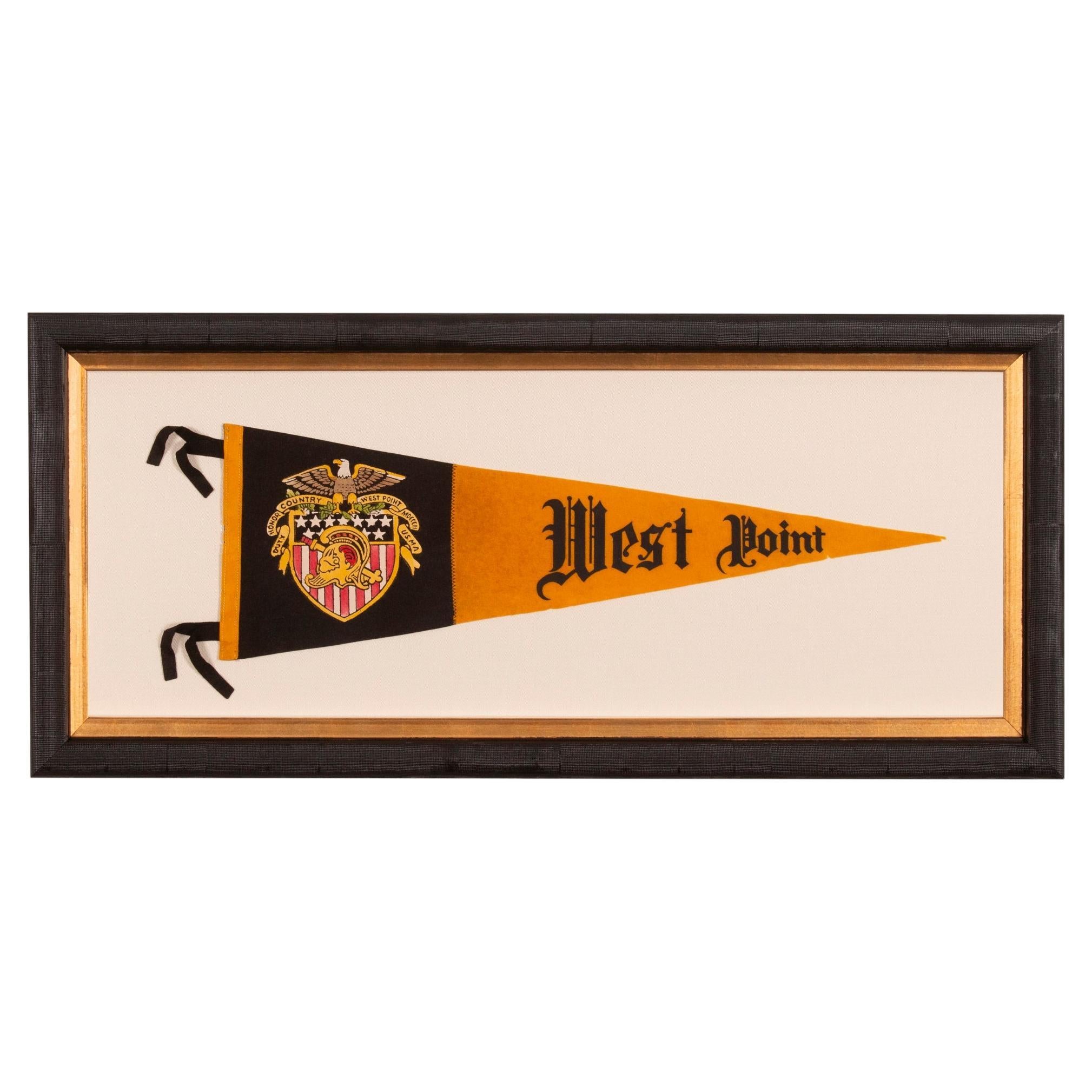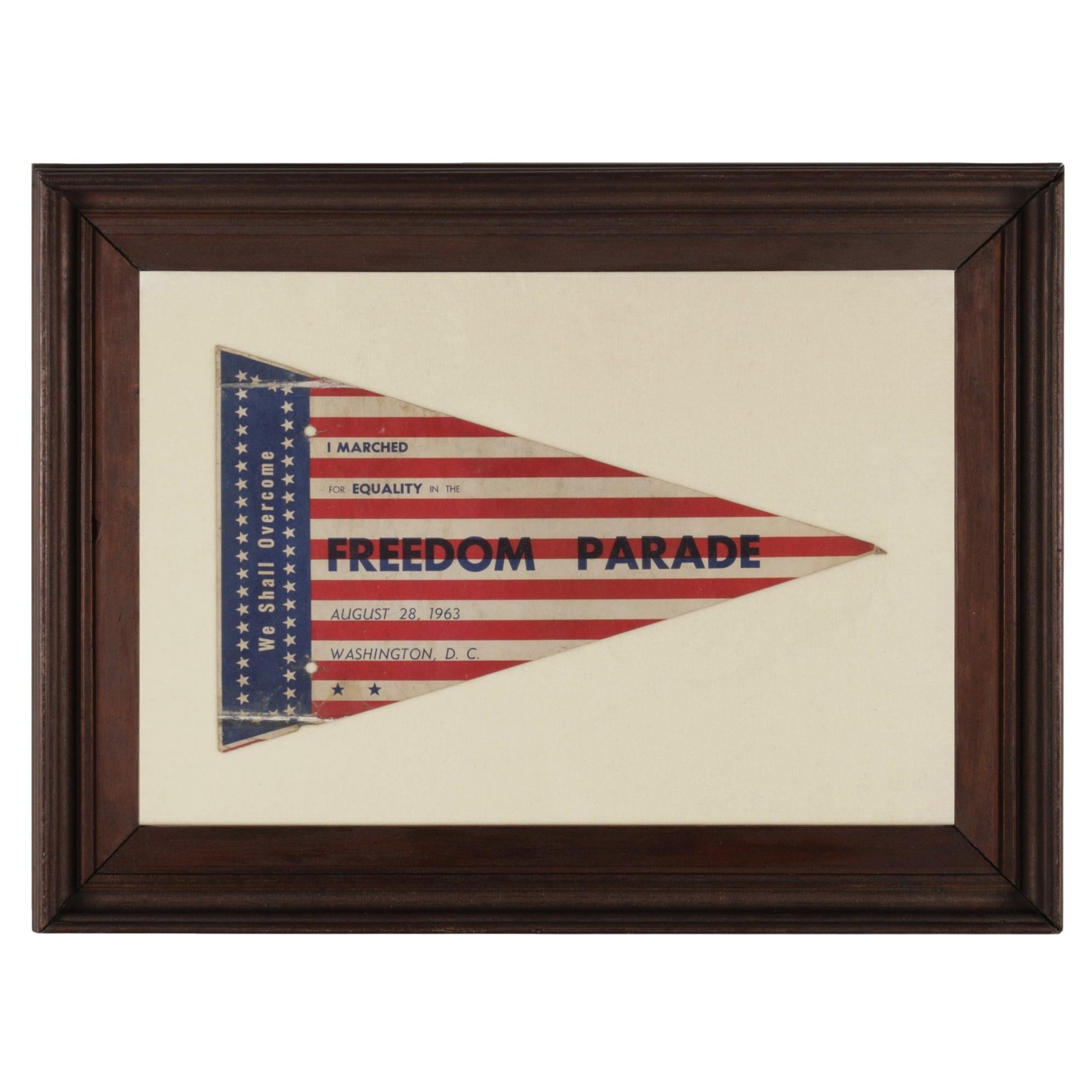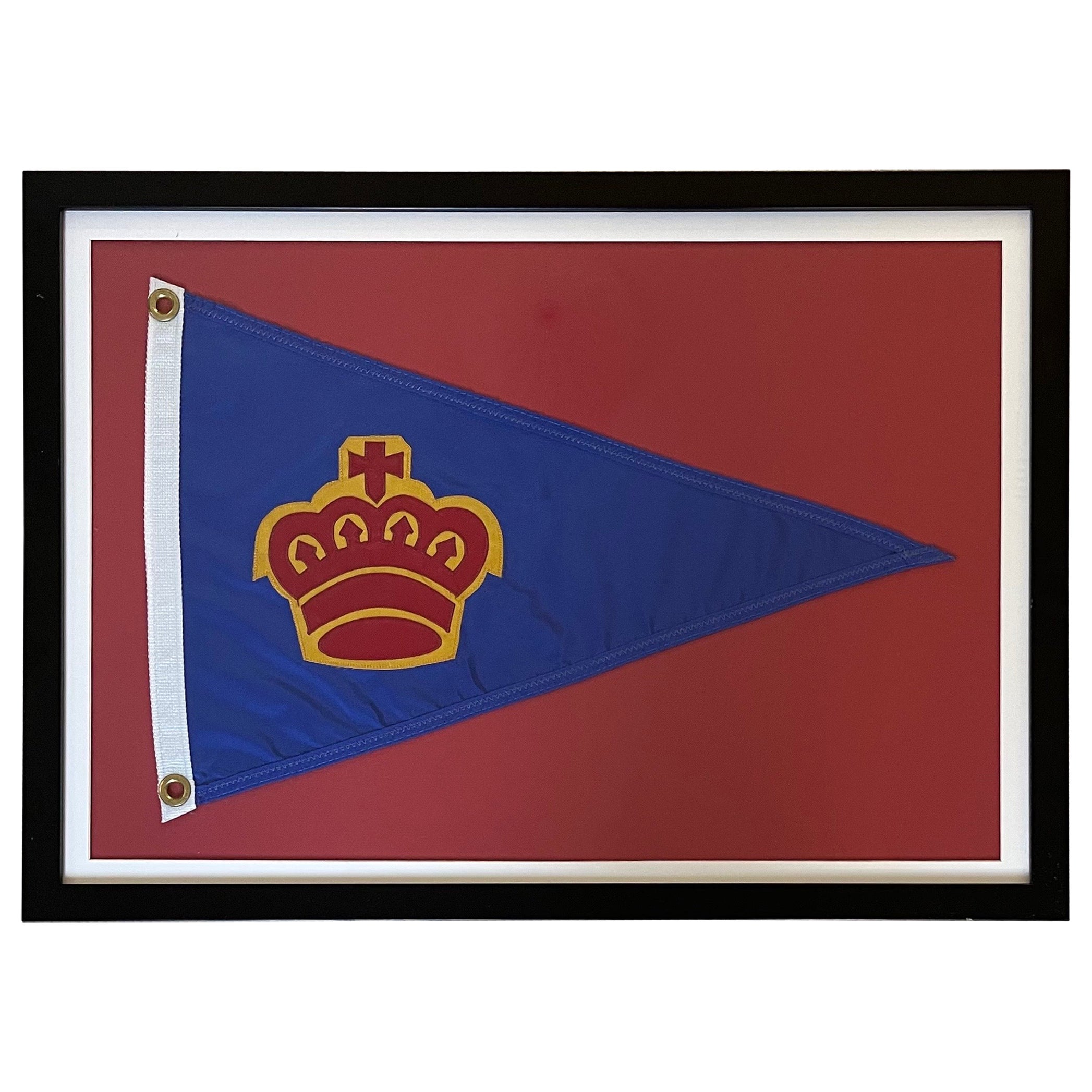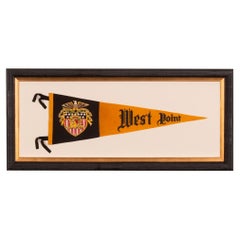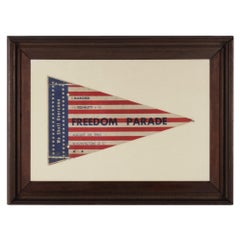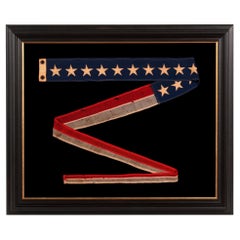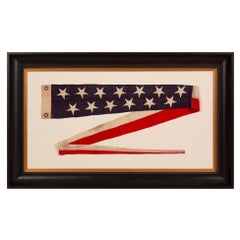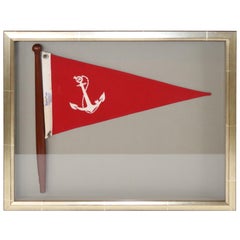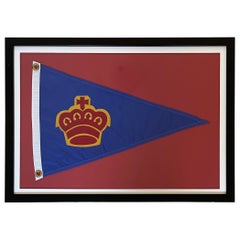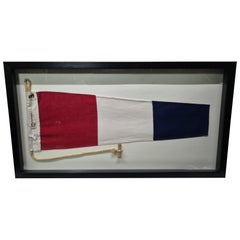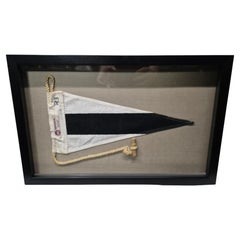Items Similar to United State Marine Corps Parris Island Pennant ca 1917-1930
Want more images or videos?
Request additional images or videos from the seller
1 of 7
United State Marine Corps Parris Island Pennant ca 1917-1930
$2,350
£1,796.70
€2,069.44
CA$3,293.07
A$3,676.40
CHF 1,926.38
MX$45,002.79
NOK 24,465.05
SEK 23,067.43
DKK 15,444.41
Shipping
Retrieving quote...The 1stDibs Promise:
Authenticity Guarantee,
Money-Back Guarantee,
24-Hour Cancellation
About the Item
UNITED STATES MARINE CORPS PENNANT FROM PARRIS ISLAND, circa WWI (U.S. INVOLVEMENT 1917-18) -1930’s
Faded, red, felt, United States Marine Corps pennant with a variant of the central device of its official seal printed in blue, yellow, gold, tan, and white pigments, and “Parris Island S.C.” in white beyond, slightly arched, extending toward the tapered point. Note the whimsical profile of the letter “c,” with an exaggerated, scrolling tail. The device generally consists of a federal eagle perched upon a globe, superimposed on a canted anchor with a whirling chain, the combination of which is to symbolize the Corps’ watchful, worldwide, maritime presence. In this instance the image was modified to fit the elongated profile of a pennant’s basic design, with the anchor rotated slightly clockwise to the horizontal, an adaptation sometimes encountered in both Marine Corps and U.S. Navy examples.
The colors used to represent the Marine Corps changed over time. The present combination of scarlet red and gold, predominant here, were formally adopted in 1925, but American military traditions tend to be as hard to extinguish as the men and women of their ranks, and the Corps was certainly no exception. 14 years would pass before the official change caught up with the Marine Corps’ flag. Between 1914 (the opening year of WWI in Europe) and 1939, this retained a deep blue ground with scarlet red streamers containing golden yellow text that read: “United States Marine Corps” and the Latin slogan “Semper Fi,” placed above and below its coat of arms, respectively.
There is a white felt binding along the hoist, with two pairs of burgundy/violet ties. Although the color of the tie can sometimes be independent from the remainder of the textile, some Marine Corps pennants of this era actually utilize this color as a background instead of red or blue, so it is not at all surprising to encounter here.
Based upon the characteristics present, and my experience with lots of early pennants across a multitude of organizations and events, I would place the date somewhere between WWI (U.S. involvement 1917-1918) and the 1930’s, though it may possibly have been made as late as WWII (U.S. involvement 1941-45).
Located just south of Port Royal, South Carolina, Parris Island has sometimes historically been spelled ‘Paris’ Island, due to inconsistencies in the spelling of the surname of the British Colonel for which it is named. Parris (Paris) purchased it in 1715, along with eight smaller islands that surround it. The name Parris Island was given when an American Naval base was established there in 1889. U.S. Marines were first stationed there two year later, in 1891. It became the primary U.S. Marine Corps recruiting depot in 1915, just before WWI, and has remained so for more than 100 years.
Mounting: For 25 years we have maintained our own textile conservation department, led by a master’s degree level graduate from one of the nation’s top programs. We take great care in the mounting and preservation of flags and related textiles and have preserved thousands of examples.
The background is 100% hemp fabric, ivory in color. The mount was placed in a dark brown, cove-shaped molding with a wood grain surface and reddish highlights, to which a black-painted, hand-gilded and distressed Italian molding was added as a liner. A shadowbox was created to accommodate the ties, which have a three-dimensional fold. The glazing is U.V. protective acrylic (Plexiglas). Feel free to contact us for more details.
Condition: There are small losses with associated loss along the top edge of the pennant, one of these just above the letter “P” and adjacent to a tack mark above the letter “N.” There is another such mark toward the fly end, and two along the white reinforcement along the hoist, and there are a couple of other tiny holes. The background has moderately to significantly faded to the current shade. One of the ties was absent. I was able to replace this by slightly modifying the originals, so no new fabric was required.
Frame Size (H x L): Approx. 19.5" x 38"
Flag Size (H x L): 8" x 26.5"
- Dimensions:Height: 19.5 in (49.53 cm)Width: 38 in (96.52 cm)Depth: 2 in (5.08 cm)
- Materials and Techniques:
- Period:
- Date of Manufacture:1917-1930
- Condition:Wear consistent with age and use. Minor losses. Minor structural damages. See Item Description.
- Seller Location:York County, PA
- Reference Number:Seller: pat-7851stDibs: LU849740905012
About the Seller
5.0
Recognized Seller
These prestigious sellers are industry leaders and represent the highest echelon for item quality and design.
Established in 1991
1stDibs seller since 2008
70 sales on 1stDibs
Typical response time: 1 to 2 days
- ShippingRetrieving quote...Shipping from: York County, PA
- Return Policy
Authenticity Guarantee
In the unlikely event there’s an issue with an item’s authenticity, contact us within 1 year for a full refund. DetailsMoney-Back Guarantee
If your item is not as described, is damaged in transit, or does not arrive, contact us within 7 days for a full refund. Details24-Hour Cancellation
You have a 24-hour grace period in which to reconsider your purchase, with no questions asked.Vetted Professional Sellers
Our world-class sellers must adhere to strict standards for service and quality, maintaining the integrity of our listings.Price-Match Guarantee
If you find that a seller listed the same item for a lower price elsewhere, we’ll match it.Trusted Global Delivery
Our best-in-class carrier network provides specialized shipping options worldwide, including custom delivery.More From This Seller
View AllWest Point Pennant with Striking Colors and Graphics, ca 1940-1950
Located in York County, PA
WEST POINT PENNANT WITH STRIKING COLOR & GRAPHICS, WWII ERA - 1950's
Triangular pennant, made for the United States Military Academy at West Point, with exceptional colors and graph...
Category
Mid-20th Century American Political and Patriotic Memorabilia
Materials
Felt
Stars & Stripe Pennant from the March on Washington, August 28, 1963
Located in York County, PA
BOLDLY GRAPHIC AND UNUSUAL STARS & STRIPES PENNANT FROM THE ‘MARCH ON WASHINGTON’ OF AUGUST 28TH, 1963, WHEN MARTIN LUTHER KING DELIVERED HIS HISTORIC "I HAVE A DREAM" SPEECH; THIS E...
Category
Vintage 1960s American Political and Patriotic Memorabilia
Materials
Paper
Price Upon Request
Commission Pennant with 13 Stars, like for Private Vessel, Ca 1892-1910
Located in York County, PA
Commission pennants are the distinguishing mark of a commissioned U.S. Navy ship. Flown at the topmast, the typical American format is a long blue field, usually with a single row of white stars, although sometimes with their total divided into two rows, followed by two long stripes, red-over-white. A ship became commissioned when this pennant was hoisted. Flown during both times of peace and war, the only time the pennant is not flown is if a flag officer or civilian official was aboard and replaced it with their own flag.
Sometimes the owners of private ships mimicked the use of Navy signals. Some seafaring men would have served in the Navy and become privy to various practices in that capacity. Others flew them purely for stylistic reasons, either on a regular basis or while the boat was dressed for special occasion. Hudson River steamers regularly flew pennants of this nature, as evidenced by period photography as well as the paintings of artists such as John and James Bard...
Category
Antique Late 19th Century American Political and Patriotic Memorabilia
Materials
Wool
Price Upon Request
13 Star Commission Pennant, 6 Foot in Length, ca 1892-1910
Located in York County, PA
6-FOOT SHIP’S COMMISSION PENNANT WITH A 5.5” HOIST AND 13 STARS IN 2 STAGGERED ROWS, LIKELY PRODUCED FOR A PRIVATE VESSEL, circa 1892-1910
Commission pennants are the distinguishing...
Category
Antique 1890s American Political and Patriotic Memorabilia
Materials
Wool
Outstanding 13 Star Hand-sewn American Private Yacht Flag, ca 1865-1885
Located in York County, PA
OUTSTANDING, 13 STAR, ANTIQUE AMERICAN PRIVATE YACHT ENSIGN WITH GREAT FOLK QUALITIES THAT INCLUDE AN UNUSUALLY WIDE ANCHOR AND A DECIDEDLY LOPSIDED RING OF 13 STARS; MADE DURING THE 2ND HALF OF THE 19TH CENTURY; ITS DEVICE HAND-SEWN AND SINGLE-APPLIQUÉD
Private yacht ensigns were approved American signals for maritime use that allowed pleasure boats to bypass customs. Though the legislation that approved them was adopted prior to 1850, almost all such flags that one will encounter were sewn by electric machine and made during the 20th century. The unusual gems among surviving examples are those that are earlier and include hand-sewn elements. Even more rare are a select few with atypical graphics. Barely any fall into both of these categories at once. Take note of the anchor on this particular flag, wide a long horizontal crossbar (stock) that contributes to uncommonly wide stance. Set within a ring of stars that is decidedly lopsided, the result is as bold as it is endearingly whimsical—two of the best qualities in American folk art, a category in which this particular example can be filed. While I have owned 13 star private yacht flags that have displayed star and canted anchor devices that were somewhat larger and/or bolder than typical, I cannot recall any that were so graphically intriguing as this one.
Brief History of Private Yacht Ensigns:
The medallion configuration, 13-star, 13-stripe flag, with a canted center anchor was entered into official use in 1848, following an act of Congress, that made it the official signal for U.S. pleasure sailing vessels. The need for such a flag arose with the popularity of boating as a pastime for well-to-do Americans, and as a competitive sport, in addition to its longstanding utilitarian role as a vehicle of trade. In early America, all boats were subject to customs searches at every port. Without modern income tax, the federal government derived its revenues mostly from tariffs, so an accounting of foreign goods on ships was a critical venture. As yachting for pleasure became more prevalent, however, more and more time was spent searching boats that had no such inventory, wasting time for both customs officials and wealthy ship owners.
John Cox Stevens, a former president of the Jockey Club and future founder of the Union League Club, became the New York Yacht Club’s Commodore upon its founding in 1845. In 1847 he approached the secretary of the treasury and suggested that something be done to streamline the customs process for non-trade vessels. In 1848, legislation passed Congress requiring registration of these boats, which could then fly the “American Yachting Signal” to bypass customs. This remained on the books until the 1980’s, when the 1848 legislation was revoked, but the use of flags in this design for decorative function continues to this day.
13 star flags have been flown throughout our nation’s history for a variety of purposes. In addition to their use on private yachts, they were hoisted at patriotic events, including Lafayette’s final visit in 1824-25, the celebration of the nation’s centennial in 1876, and the sesquicentennial in 1926. They were displayed during the Civil War, to reference past struggles for American liberty and victory over oppression, and were used by 19th century politicians while campaigning for the same reason. The U.S. Navy used the 13 star count on small boats until 1916, because it was easier to discern fewer stars at a distance on a small flag. Commercial flag-makers mirrored this practice and some private ships flew 13 star flags during the same period as the Navy.
Construction: The stars and anchor are made of cotton, hand-sewn, and single-appliquéd. This means that they were applied to one side of the canton, then the blue fabric was cut from behind each star, folded over, and under-hemmed, so that one star could be viewed on both sides of the flag. I always find single-appliquéd stars more interesting, not only because they are evidence of a more difficult level of seam-work and stitching, but also because they are more visually intriguing. The two visible rows of hand-stitching emphasize their hand-sewn construction. For these reasons, single-appliquéd stars often appeal to connoisseurs of early American textiles...
Category
Antique Mid-19th Century American Political and Patriotic Memorabilia
Materials
Wool
Price Upon Request
West Point Window Banner, Made Approx. US Involvement in WWI (1917-1918)
Located in York County, PA
PATRIOTIC WEST POINT WINDOW BANNER, PROBABLY MADE AROUND THE TIME OF U.S. INVOLVEMENT IN WWI (1917-18), A WONDERFUL EAMPLE WITH THE ACADEMY CREST & A SALMON RED BINDING
Small window...
Category
Mid-20th Century American Political and Patriotic Memorabilia
Materials
Felt
Price Upon Request
You May Also Like
Framed Nautical Bow Pennant with Anchor
Located in Norwell, MA
Framed nautical pennant on mast with a red field and white fouled anchor by Taylor. Fitted to a custom shadow box. Weight is 9 pounds.
Category
Vintage 1950s Nautical Objects
Materials
Cotton
Mid-Century Framed Yacht Club Flag
Located in San Diego, CA
A very cool mid-century framed yacht club flag, circa 1960s. The flag is presented in a black wood frame with a red back ground. The overall piece meas...
Category
Mid-20th Century American Mid-Century Modern Nautical Objects
Materials
Paper
$340 Sale Price
20% Off
Nautical Signal Pennant for Numeral THREE in Frame
Located in Norwell, MA
Genuine international maritime signal flag in a custom shadowbox frame. The cotton flag represents the numeral "3". The pennant has a white canvas hoist with a sisal rope and wood to...
Category
Vintage 1950s North American Nautical Objects
Materials
Cotton
Nautical Signal Pennant in Shadowbox Frame
Located in Norwell, MA
Genuine international maritime signal flag in a custom shadowbox frame. The cotton flag represents the substitute flag R3. The pennant has a white canvas hoist with a sisal rope and ...
Category
Vintage 1950s North American Nautical Objects
Materials
Cotton
Nautical Signal Pennant for Numeral "FIVE" in Frame
Located in Norwell, MA
Genuine international maritime signal flag in a custom shadowbox frame. The cotton flag represents numeral "5". The pennant has a white canvas hoist with a sisal rope and wood toggle...
Category
Vintage 1960s North American Nautical Objects
Materials
Cotton
Nautical Signal Pennant for Numeral "NINE" in Frame
Located in Norwell, MA
Genuine international maritime signal flag in a custom shadowbox frame. The cotton flag represents numeral "9". The pennant has a white canvas hoist with a sisal rope and wood toggle...
Category
Vintage 1950s North American Nautical Objects
Materials
Cotton
More Ways To Browse
1917 Furniture
Antique Marine Furniture
Small Antique Globes
Royal Memorabilia
Small American Flag
Antique Letter N
Navy Flags
Great Seal Of The United States
Federal Eagle
Tail Coat
Antique Anchor Chain
Antique Hemp
Antique British Flag
Antique Military Memorabilia
Antique Hoist
Maritime Antiques
Eagle And Flag
WWII Flags
